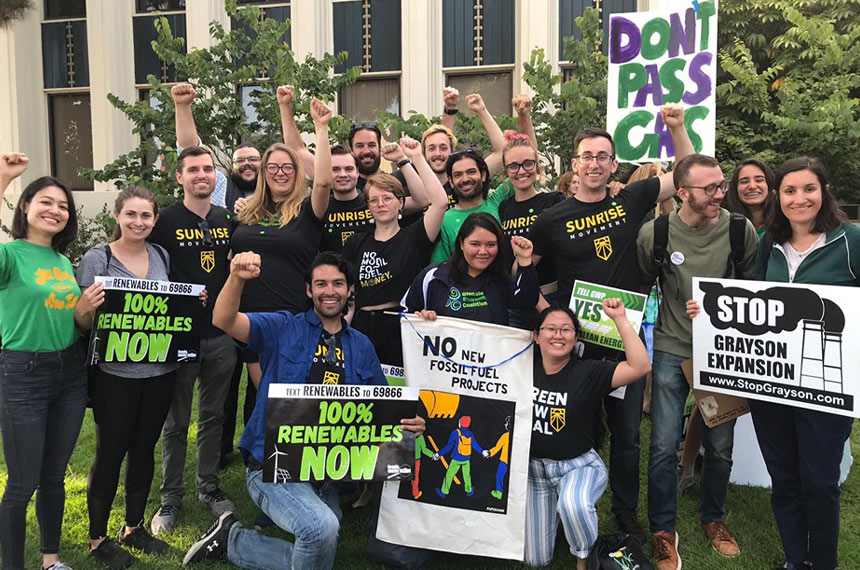Stop Gas at Grayson Again
Final Decision on Grayson Gas Engines Tuesday, December 13, 2022
FAQ
1. How much fossil fuel capacity is in GWP’s 2021 Grayson Repowering project and what else is in the proposal?
A. GWP is proposing 93-101 MW of gas-burning equipment: 93 MW in Alternative 7 (5 new internal combustion engines), or 101 MW in Alternative 8 (2 refurbished gas units). Each option includes 75 MW of battery storage.
2. Is this fossil fuel content the lowest level we can achieve?
A. It’s lower than the 262 MW proposed in 2017, and that is thanks to sustained citizen advocacy, which translated to support from City Council and positive movement by GWP. But we can do much better. The utility has not exhausted our clean energy options or moved urgently to get clean energy online. New fossil fuel investments should be a last resort and they should be minimized.
3. How does GEC want City Council to act on this proposal?
A. We ask Council to direct GWP to propose a NEW project mix with much more clean energy and much less or no gas. We want, and believe it’s possible to get, system reliability with much more clean energy, and a better financial plan for a 100% clean energy future. All this is imperative to address the existential climate crisis we face.
4. Have alternatives been considered?
A. City Council placed conditions on GWP’s 2019 proposal for 93 MW of new gas units, and 75 MW of battery storage and asked staff to look for ways to reduce or eliminate the need for natural gas generation before requesting approval to make new investments in fossil fuel equipment. Unfortunately, the proposal before Council has the same amount of gas as what was proposed in 2019.
5. What are the GWP clean energy programs I’ve heard about?
A. There are now two local (and local is the key word) clean energy projects from the 2019 IRP online: the Franklin “Peak Savings Program” and the Lime Energy Business Energy Upgrade Program. There is one project still being negotiated: the Sunrun Virtual Power Plant. These came out of the Clean Energy Request For Proposals process in 2018. Currently, the city is actively exploring city-sited solar.
GWP has not proposed new alternatives to the gas equipment in two and a half years. Despite direction from Council, there is no recommended alternative with less gas than the 2019 plan. The Environmental Impact Report on the Grayson Repowering lists alternatives with less or no gas, but they are rejected within the report, and do not appear to have been properly re-considered in light of new transmission opportunities.
6. Could the 72 MW Glendale will receive on its Southwest Transmission Line beginning in 2027 reduce the need for gas-burning equipment?
A. Yes. This transmission opportunity did not exist in 2019, and at that time GWP said there was no way to get additional transmission! It does exist now, and yet the proposal remains the same. GWP should be congratulated for pursuing this opportunity, and we should also see the benefits reflected in our city’s energy planning.
7. What are the main reasons GWP wants to invest in 93 MW of new gas infrastructure?
A. There are two main reasons. Other energy resources in Glendale’s portfolio meet everyday needs, and even the peak demand on the hottest summer evenings. But Glendale also needs additional energy resources to hold in reserve for situations like a downed transmission line—like insurance against worst-case scenarios. Once the equipment is installed, GWP plans to run it to meet peak demand—up to 15% of the year. GEC believes we should address the few peak load days by building clean energy reserves and by managing demand via load-shifting programs, because the energy we don’t use is the cheapest energy of all!
Considering the additional transmission coming in 2027, we need to figure out exactly how much energy we need to get us from the January 2024 retirement deadline of the old gas units to when the new transmission comes online in 2027. Then we can figure out how much of it can be met with clean energy (perhaps all?), so we invest the smallest amount possible in fossil fuels.
8. Isn’t $200M or more a lot of money for gas infrastructure that would rarely be used to its full capacity?
A. The Grayson project will cost hundreds of millions of dollars. The main rationale for adding this energy capacity is to meet “reserve” requirements, as described above, and it will help in the short term until new transmission comes online. This is incredibly expensive insurance, and a lot of money to spend for equipment that will sit idle most of the time. There are cleaner and more affordable ways to meet or reduce Glendale’s energy needs. Plus, this technology may well be obsolete or legally prohibited long before the end of its useful lifetime. Glendale ratepayers will foot the bill and may end up paying twice, because we will need more clean energy in the coming years whether this gas equipment is installed now or not. Instead, we could invest in technology that can last for the long term.
9. Will the new or refurbished gas equipment pollute less than what’s in use now?
A. Yes. But we really need to avoid all new emissions whenever possible. We should be designing a system that relies on clean energy resources and peak load reduction strategies, with minimal emissions from the remaining Grayson Unit 9, which will remain in service, and the emissions from the Magnolia gas plant in Burbank. Much less is much better than less.
BECAUSE GLENDALE CAN DO BETTER!

